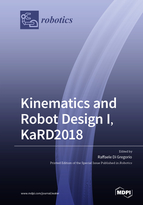Kinematics and Robot Design I, KaRD2018
A special issue of Robotics (ISSN 2218-6581).
Deadline for manuscript submissions: closed (15 September 2018) | Viewed by 102679
Special Issue Editor
Interests: kinematics; dynamics; mechanism and machine theory; parallel manipulators; robot mechanics; biomechanics; vehicle mechanics; robotics
Special Issues, Collections and Topics in MDPI journals
Special Issue Information
Dear Colleagues,
Kinematics enters many aspects of robot design. Type synthesis, dimensional synthesis, kinematic analysis, singularity analysis, workspace determination, performance measures, accuracy analysis, path planning and obstacle avoidance are only some of these. In addition, it is central when building dynamic models for simulation purposes.
Additionally, robotics is pervading many fields of social interest. For instance, healthcare with its robotized medical devices and rehabilitation devices needs studies both on human biomechanics and on mechanism synthesis, which involve kinematics.
Nowadays, a numerous scientific community is involved in such studies and, even though many conferences (ARK, CK, ASME MR, etc.) on robot and/or mechanism kinematics take place regularly, there is room for further initiatives. This open-source Special Issue with cheap publication costs wishes to provide a good opportunity for presenting research results that are immediately readable and usable by other researchers.
The Special Issue aims at collecting recent research on all the below-listed topics. Review papers are also welcome.
Topics of interest include (but are not limited to):
- synthesis of mechanisms
- theoretical and computational kinematics
- robot modeling and simulation
- kinematics in robot control
- position analysis
- mobility and singularity analysis
- performance measures
- accuracy analysis
- path planning and obstacle avoidance
- novel manipulator architectures
- metamorphic mechanisms
- compliant mechanism analysis and synthesis
- micro/nanomanipulator design
- origami-based robotics
- medical and rehabilitation robotics
- kinematics in biological systems, humanoid robots and humanoid subsystems
Prof. Dr. Raffaele Di Gregorio
Guest Editor
Manuscript Submission Information
Manuscripts should be submitted online at www.mdpi.com by registering and logging in to this website. Once you are registered, click here to go to the submission form. Manuscripts can be submitted until the deadline. All submissions that pass pre-check are peer-reviewed. Accepted papers will be published continuously in the journal (as soon as accepted) and will be listed together on the special issue website. Research articles, review articles as well as short communications are invited. For planned papers, a title and short abstract (about 100 words) can be sent to the Editorial Office for announcement on this website.
Submitted manuscripts should not have been published previously, nor be under consideration for publication elsewhere (except conference proceedings papers). All manuscripts are thoroughly refereed through a single-blind peer-review process. A guide for authors and other relevant information for submission of manuscripts is available on the Instructions for Authors page. Robotics is an international peer-reviewed open access monthly journal published by MDPI.
Please visit the Instructions for Authors page before submitting a manuscript. The Article Processing Charge (APC) for publication in this open access journal is 1800 CHF (Swiss Francs). Submitted papers should be well formatted and use good English. Authors may use MDPI's English editing service prior to publication or during author revisions.
Keywords
- mechanism synthesis
- kinematic analysis
- robot modeling and simulation
- robot control
- singularity analysis
- performance measures
- accuracy analysis
- path planning
- parallel manipulator
- serial manipulator
- robot design
- compliant mechanism
- micro/nanomanipulator
- origami-based robotics
- medical and rehabilitation robotics
- biomechanics
Related Special Issues
- Kinematics and Robot Design II, KaRD2019 in Robotics (7 articles)
- Kinematics and Robot Design III, KaRD2020 in Robotics (10 articles)
- Kinematics and Robot Design IV, KaRD2021 in Robotics (12 articles)
- Kinematics and Robot Design V, KaRD2022 in Robotics (13 articles)
- Kinematics and Robot Design VI, KaRD2023 in Robotics (10 articles)






